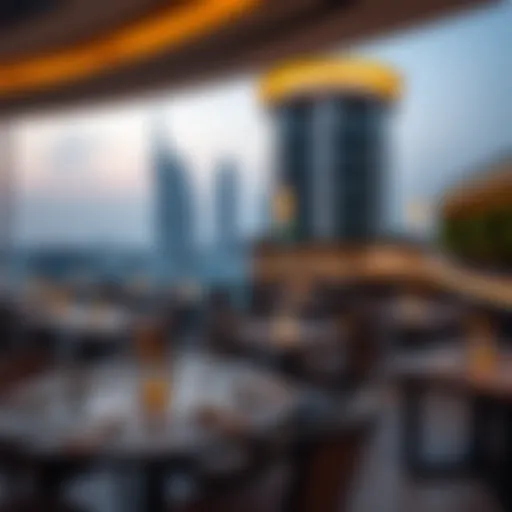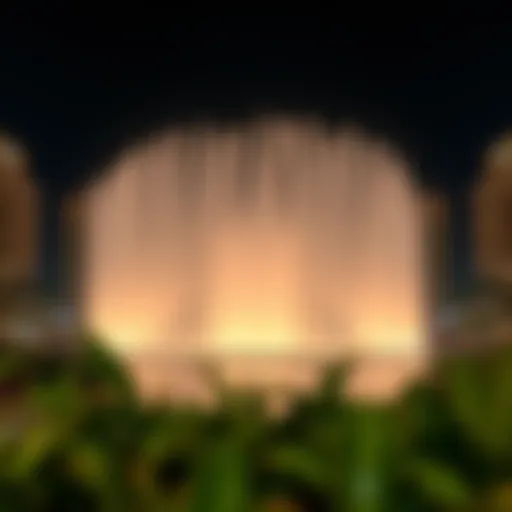Discovering the Rich Tapestry of Dubai's Spice Souk


Intro
Nestled within the vibrant streets of Dubai, the Spice Souk stands as a testament to the rich history that has shaped this dynamic city. With its narrow winding alleys and aromatic spices, this market offers an immersive experience that's hard to replicate elsewhere. For locals and tourists alike, the souk is not just a market; it's a cultural melting pot where the scents of cardamom, saffron, and cinnamon waft through the air, drawing visitors in and whisking them away to a world of flavors.
Historically, the Spice Souk has roots that intertwine with Dubai's past as a trading hub. It has served as an essential stop along ancient trade routes, where merchants exchanged goods and stories from distant lands. Today, it holds a dual significance; it is both a bustling marketplace where lively bargaining takes center stage and a cultural landmark that reflects the traditions and heritage of the region. Understanding this depth provides insight into why the souk is such a cherished part of the Dubai experience.
Whether you’re an aficionado of spices or simply a curious traveler, the Dubai Spice Souk is an instant invitation to explore the universe of flavors. As we delve deeper, we’ll navigate the major elements that enhance the experience. From the wide variety of spices available to the art of negotiating with local vendors, every aspect of a visit to the souk is a step into the rich tapestry of Dubai’s culture.
Foreword to the Dubai Spice Souk
The Dubai Spice Souk represents not just a marketplace, but a vibrant tapestry woven from the threads of history, culture, and culinary excellence. This section shines a light on its enduring significance, setting the stage for a deeper understanding of what this souk embodies.
Historical Background
Nestled in the heart of Dubai, the Spice Souk is a relic of the past, echoing the days when traders traveled the ancient trade routes. Established in the late 19th century, the souk thrives on a history steeped in commerce and culture.
For centuries, merchants exchanged spices such as cardamom, turmeric, and saffron, which were not only valued for their flavor but also for their medicinal properties. These spices sailed from far-off lands, ushered into the local economy by the beckoning of the Arabian Gulf. Traditional dhows laden with fragrant goods made their way along the coast, creating a sense of interconnectivity between peoples and cultures.
This rich heritage remains alive today, with narrow lanes and bustling shops reminiscent of a bygone era.
Cultural Significance
The Spice Souk is far more than a place to buy and sell. It stands as a cultural beacon where the essence of Emirati hospitality is palpable. The aroma of spices mingles with the chatter of merchants and customers, crafting an atmosphere that feels both enchanting and familiar.
Visitors can experience the cultural diversity that has been part of the souk for years. Locals and expatriates gather here, exchanging stories, recipes, and a shared appreciation for the craft of cooking. This souk not only showcases the spices that define Arabian cuisine but also serves as a meeting point for different cultures, reinforcing Dubai's status as a global crossroads.
Furthermore, the souk is a physical manifestation of the city's growth and transformation, preserving traditions while adapting to the modern world.
Modern-Day Relevance
In today's fast-paced environment, the Dubai Spice Souk holds its own, standing as a cornerstone of the local economy. It attracts a growing number of tourists, crossing paths with culinary enthusiasts eager to explore and discover. The souk is more than just an intriguing destination—it is a critical component of Dubai’s tourism industry.
Modern trends signify a broader interest in organic and health-conscious spices, pushing local vendors to adapt. The rise in online shopping has also encouraged merchants to explore new sales channels while preserving the authentic experience of shopping in the souk.
Moreover, visitors revel in the art of bargaining—a skill honed over generations, adding a touch of playfulness to each transaction. Thus, the souk remains a pivotal part of not only preserving cultural traditions but also driving economic prosperity in a bustling, global city.
A Walk Through the Spice Souk
Exploring the Dubai Spice Souk is akin to stepping into a vibrant tapestry woven with history, aroma, and culture. This section illuminates the pathways through the souk, capturing not just the essence of what lies within its maze-like alleys but also the unique experiences that await. Understanding how to navigate this market is paramount; it transforms a mere visit into an immersive journey.
Navigating the Souk
Navigating the souk can be compared to a rite of passage. First-time visitors might find themselves overwhelmed by the sights and sounds but fear not. To find your way, start at the entrance, where a symphony of scents wafts through the air, beckoning you closer. The souk is organized into clusters, each with its own theme, from spices to fragrances. Following the aromatic trails leads you to particular sections where specific spices reign supreme.
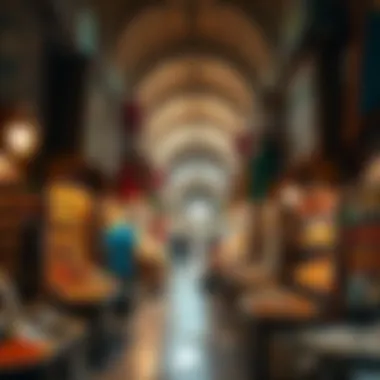

When you wander through the winding paths, you might encounter a tapestry of colors from deep burgundy paprika to the bright yellows of turmeric. It’s best to take your time, as each stall tells its own story, often through the weary hands of local merchants who have cultivated their trade through generations.
"The souk is not merely a market, it is a living museum of Dubai's heritage."
Additionally, learning a few basic Arabic phrases can go a long way. Simple greetings can melt away barriers and create a more inviting atmosphere. Keep an eye on your surroundings; while residents may know the unspoken rules of the market, understanding the ebb and flow will enhance your experience immensely.
Sensory Experiences
The sensory experiences in the Spice Souk are nothing short of enchanting. Upon entering, the air is thick with the intoxicating aromas of spices that can transport one across continents. Each spice has a narrative, often linked to its origins and how it became intertwined with local and global cuisines. The contrast of sweet cardamom and spicy cumin, mingling with earthy saffron, creates a multi-dimensional olfactory experience.
Merchants display their goods in woven baskets, and it’s not unusual to be invited to sample some of the wares. From tasting a pinch of sumac sprinkled over a slice of fresh bread to inhaling the heady scent of dried rose petals, every engagement not only tantalizes taste buds but also ignites curiosity.
As the sun sets, the souk transforms. The dimming light casts shadows, highlighting the textures and colors of the spices. The atmosphere buzzes with chatter and laughter, offering a glimpse into the social fabric that holds this marketplace together.
Engaging with Merchants
Engaging with merchants in the Dubai Spice Souk can be a true cultural exchange. They are the custodians of knowledge, ready to share tales about the origins of their spices and the best ways to use them. This interaction is not just transactional; it is an opportunity to delve deeper into a culture that values tradition and craftsmanship.
When approaching a stall, it helps to be curious and ask questions. Rather than haggling immediately over prices, show genuine interest in the spices. Ask about how saffron is harvested or the distinct flavors of cloves. These conversations enrich the experience, allowing you to connect personally with the product.
Keep in mind that bargaining is an art form here. It’s customary to negotiate, and often merchants delight in the dance, enjoying the banter as much as the sale. For them, each exchange is part of a long-established tradition that blends commerce with camaraderie.
Visiting the Dubai Spice Souk isn't merely a shopping trip; it's a pilgrimage through history and a dive into the heart of the city's cultural nexus. Whether one is a culinary enthusiast or a casual traveler, the souk houses stories and experiences that resonate long after leaving its aromatic embrace.
Types of Spices and Their Uses
In the realm of culinary delights and traditions, spices take center stage, particularly in the Dubai Spice Souk. Not just mere flavor enhancers, spices are deeply intertwined with cultural stories and practices. Exploring the variety of spices and their unique applications helps illuminate how they contribute to richer dining experiences in both traditional and modern contexts.
Traditional Spices
Cardamom
Cardamom stands out as one of the most cherished spices, often referred to as the "queen of spices". This spice packs a punch, lending a distinctive flavor that can be both sweet and savory. Cardamom is not just popular for its taste but also for its health benefits, including digestive support and antioxidant properties. It is a star in Middle Eastern coffee and desserts, bringing warmth and depth to dishes. One unique feature of cardamom is its aromatic pods; these little capsules are often used whole in cooking, allowing for a concentrated burst of flavor. However, it can be on the pricier side compared to other spices, a consideration for the discerning buyer.
Cinnamon
Cinnamon is another beloved spice that carries a dual identity; it’s equally at home in sweet pastries as in savory Middle Eastern dishes. This warm spice has been used for centuries, both as a flavorful addition to meals and as a medicinal ingredient. The notable characteristic of cinnamon is its sweet yet spicy undertone, which makes it versatile in various cuisines. In the souk, you can find different types of cinnamon, each with its distinctive flavor profile. The unique feature of this spice lies in its aromatic bark, which can be used whole or ground. Although it's widely available, many might not realize that the quality can vary significantly, impacting the flavor experience.
Saffron
When it comes to luxury spices, saffron reigns supreme. Known for its striking golden hue and distinct flavor, saffron is the most expensive spice by weight. This exclusivity stems from the painstaking process of harvesting its delicate threads, which bloom only under specific conditions. Saffron is favored for its medicinal qualities and unique ability to impart earthy and slightly sweet flavors. It is frequently used in Persian rice dishes and luxurious desserts, making it a staple in the kitchens of the culturally rich regions. However, the price tag can be steep; buyers need to be wary of imitations, which could diminish the experience.
Herbs and Blends
Za'atar
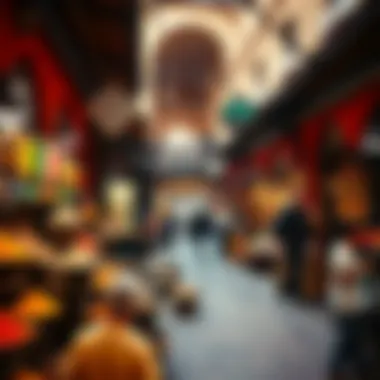

Za'atar, a traditional Middle Eastern blend, combines herbs, spices, and sesame seeds, creating a versatile seasoning that can elevate nearly any dish. Its strong flavor profile often includes thyme, oregano, and sumac, contributing to both the taste and the aromatic experience of food. The delightful combination of earthy and slightly tangy flavors makes za'atar a favorite to sprinkle on bread or mix with olive oil for dipping. The unique feature of za'atar is its customizable nature; every region or family may have their own blend, adding to its cultural significance. It serves well in both contemporary and traditional meals, appealing to a wide range of palates.
Sumac
Sumac is another essential ingredient, known for its tangy, lemony flavor that enhances salads, meats, and dips like hummus. Its vibrant red color adds a visual appeal to dishes. The key characteristic that sets sumac apart is its ability to provide acidity without the liquid of lemon juice; this makes it a beloved option among chefs. Its unique feature lies in the simplicity of its ingredient—dried and ground sumac berries. While prevalent in many Middle Eastern dishes, it's gaining popularity worldwide, although some might find it less familiar than other spices.
Harissa
Harissa brings a notable kick to the spice blend arena. This fiery chili paste, hailing from North Africa, is crafted from a dynamic mixture of hot peppers, garlic, cumin, and coriander. The heat level and flavor can vary widely, depending on the specific ingredients, making it a versatile addition to various dishes. Harissa's key characteristic is its transformative ability; a small amount can impart depth and heat to otherwise simple meals. One advantage is its ease of use, but the drawback is the heat level may not suit everyone’s palate, requiring some caution.
Current Trends in Spice Preferences
As cuisine evolves, so do preferences for spices. The rise in interest around health-conscious and plant-based diets has brought new spices and blends to the forefront. Ingredients like turmeric, known for its anti-inflammatory properties, and innovative spice blends that cater to contemporary tastes are increasingly popular. With globalization and culinary curiosity on the rise, the spice market continues to adapt and intrigue adventurers and food enthusiasts alike.
The Art of Bargaining
Navigating the bustling alleys of the Dubai Spice Souk isn’t just about shopping; it’s a lesson in the art of bargaining. This skill is woven deeply into the fabric of the souk’s culture, acting as the dance between buyer and seller. Knowing how to negotiate effectively not only can save you money but also enriches your overall experience. The souk thrives on the spirit of haggling, transforming what could be a mundane shopping trip into a captivating interaction steeped in history and tradition.
Understanding Market Dynamics
In the Spice Souk, just like in any marketplace, understanding the market dynamics is key. Prices are not fixed. Instead, they ebb and flow based on factors like supply, demand, and seasonality. Merchants gauge the eagerness of buyers; those who seem less invested might encounter a higher price. It’s like a chess game where observing your opponent’s moves can lead to victory. Often, if you walk away, a seller might call you back with a better offer.
Moreover, familiarity with the spices and their worth can give you a leg up. For instance, premium saffron from Iran or Kashmir comes at a premium; hence, recognizing its value helps you negotiate confidently. Conversely, less sought-after spices may allow for more flexibility in pricing. Here’s a quick snapshot of why grasping these market dynamics is essential:
- Power Balance: Understanding supply and demand allows you to make informed decisions.
- Psychology: Sellers often create a sense of urgency, pushing buyers to settle for less.
- Cultural Norms: Bargaining is an integral part of the shopping experience here, so participating fully is key.
Being aware of these factors allows for a richer engagement, deepening your connection to both the market and its people.
Strategies for Effective Negotiation
Now that you recognize the significance of the market's pulse, here are some practical strategies that can help you in negotiations:
- Do Your Research: Before stepping into the souk, familiarize yourself with the typical prices of the spices you want. This groundwork ensures you don’t get taken for a ride.
- Start Low: Begin your offer lower than what you’re willing to pay. This allows room for the seller to counter, making it feel like a win-win situation.
- Be Respectful and Friendly: Approach the conversation with a smile and politeness. Building rapport can lead to more favorable outcomes. Merchants appreciate customers who engage pleasantly.
- Utilize Body Language: Exhibiting interest through your tone and facial expressions can greatly influence the negotiation. Sellers can pick up on these cues, helping you secure a better deal.
- Avoid Showing Too Much Interest: If a seller senses that you are highly interested in a product, they may not budge on price. Maintain a cool demeanor to keep your options open.
- Be Prepared to Walk Away: Sometimes, the best tactic is to simply walk away if the price doesn’t feel right. This often prompts the seller to reconsider.
In summary, bargaining in the Dubai Spice Souk is as much about skillful negotiation as it is about immersing yourself in the culture. By understanding market dynamics and employing effective strategies, you transform the act of shopping into an enriching experience that echoes the souk's vibrant history and traditions.
Remember, it’s not just about getting a good price; it’s about the experience that comes with it.
Impact on Dubai's Economy
The Dubai Spice Souk is not just a vibrant market full of colors and scents; it plays a substantial role in the economical web of Dubai. This contribution can be seen an ongoing foundation of local trade, cultural exchange, and entrepreneurial spirit that breathes life into the very essence of the city. The souk is a microcosm of broader economic trends, acting as a barometer for shifts in market demands and consumer preferences.
Economic Contributions of the Souk
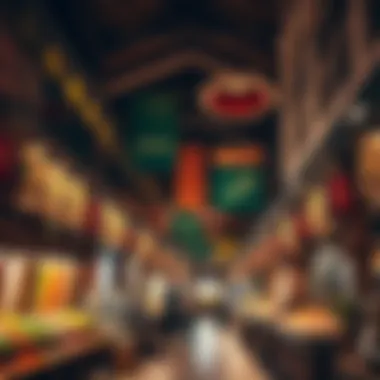

The Dubai Spice Souk contributes significant value to the local economy through both direct and indirect channels. Directly, it creates a steady flow of income for numerous merchants ranging from spice traders to traditional craftsmen. This small but mighty market attracts thousands of tourists every year, each person bringing purchasing power that fuels local businesses and enhances the livelihood of the merchants.
- Market Stability: The souk's enduring popularity reflects its ability to adapt to both local and global economic changes. Visitors, whether they are looking for traditional spices or modern blends. The presence of these visitors adds not only to sales but fosters community dialogues amongst traders.
- Job Creation: Many families rely on the spice souk for their living, creating smoother pathways for employment within the community. From selling spices to preparing traditional dishes, the income generated provides sustenance and stability for countless locals.
- Cultural Exchange: The souk is an intersection of global cultures where everyone from an unassuming backpacker to seasoned chefs seeks out authentic flavors. This interplay encourages cultural understanding and tolerance which in itself has invaluable economic implications.
Tourism and Local Business
Tourism is the lifeblood of Dubai, and the Spice Souk plays a strategic role in this bustling industry. The unique appeal of the souk lies in its authenticity; a wander through its narrow lanes is a journey into the past and a testament to Dubai's trading history. This draws not only tourists but investors and business enthusiasts, encouraging further development in the area generally.
- Attraction Point: The souk serves as a major attraction, fostering an ecosystem where various businesses thrive. Restaurants, cafes, and small boutiques benefit from the foot traffic generated by visitors who come to explore the aromas of spices.
- Local Craftsmanship: Many of the products sold in the souk are handmade by local artisans. This not only stimulates the economy but also keeps age-old traditions alive, making every purchase an investment in heritage.
- Real Estate Appeal: With the burgeoning interest in the Spice Souk, nearby properties naturally become more desirable for both residential and commercial use. Local businesses have increased their operations, thus providing better services and opportunities as this corner of the city becomes more lively.
The overall impact of the Spice Souk on Dubai's economy is a fascinating example of how history, culture, and commerce intertwine, proving that the souk remains a cornerstone in both the local and regional economies. As this market continues to thrive, it mirrors the resilience and adaptability of Dubai itself, offering a lens through which one can view the evolving landscape of this enchanting city.
Practical Tips for Visitors
Visiting the Dubai Spice Souk can be a vibrant experience full of colors, aromas, and sounds that beckon travelers from all around the globe. Having practical tips in hand can transform an enthusiastic padding-around into a memorable adventure. Understanding how to navigate the souk, ensuring safety, and knowing what else to explore nearby is pivotal.
Best Time to Visit
Timing is everything, they say, and it couldn't be truer for the Spice Souk. The best time to visit is generally outside the sweltering heights of summer. Early morning or late afternoon can be optimal. Not only does this help you beat the heat, but it also allows you to experience the souk at its liveliest. Weekdays tend to be less crowded compared to weekends. And let’s be frank, navigating through throngs of people while trying to savor all those delightful spices can be a real chore.
Safety and Etiquette
Traveling in a new environment comes with mixed feelings of excitement and apprehension. Safety should never take a backseat. The Spice Souk is relatively safe, but it’s wise to stay vigilant. Avoid flaunting valuables or getting overly friendly with strangers. Moreover, dressing modestly is recommended as a sign of respect for local customs. When bargaining or engaging with merchants, keep it friendly. A warm smile can go a long way, and treating the local merchants with respect can sometimes lead to better deals.
Nearby Attractions
Once you've soaked in the aromatic pleasures of the Spice Souk, your journey doesn't have to stop there. Close by is the Gold Souk, where you can enjoy another thrilling shopping experience filled with dazzling jewelry. Another option is the Dubai Creek, where you can take a leisurely abra ride—this is essentially a traditional boat that offers a stunning view of the city and a chance to sink into Dubai's history at the same time. And let’s not forget the Dubai Museum in Al Fahidi Fort, where history unfurls in a captivating manner, blending the ancient and the modern.
In summary, seeking practical tips for visiting the Dubai Spice Souk not only enhances your experience but ensures you make the most of your time in this magnificent market. Plan to go during peak moments while keeping your wits about you. With every spice that wafts through, the allure of Dubai becomes all the more tangible.
The End
The closing thoughts on the Dubai Spice Souk provides rich insights into its importance not only within the vibrant tapestry of Dubai's heritage but also in its continued relevance today. A tapestry woven with threads of history, culture, commerce, and community, the Spice Souk remains a proud emblem of the past and a beacon for future generations.
Reflection on Cultural Heritage
The Dubai Spice Souk serves as a living gallery of cultural exchange. Each spice, from sumac to cinnamon, tells a story, echoing ages of trade and tradition that date back centuries. Its intricate layout invites wanderers to lose themselves among vivid displays of spices stacked high, intriguing aromas wafting through the air. The merchants, often multi-generational, carry the legacy of their craft, presenting a striking melding of tradition and contemporary dynamics.
It's more than a market; it's a celebration of history. The spices and herbs offered are not just commodities. They reflect the region's agricultural richness and its historical connections to trade routes, which enabled knowledge fusion and cultural diversity. Engaging with the Spice Souk not only enhances one’s culinary repertoire but also roots individuals in the deep currents of human interaction and shared stories. Investors and real estate developers, looking to understand the fabric of Dubai's culture, would do well to appreciate how such a site embodies a collective identity, fostering a sense of community and place in a rapidly globalizing world.
The Future of the Dubai Spice Souk
Looking forward, the future of the Dubai Spice Souk presents a complex yet promising landscape. With the surge of digital commerce, traditional markets face both challenges and opportunities. Local businesses are beginning to embrace e-commerce, allowing them to reach a broader audience while simultaneously maintaining local customs. This hybrid model can propel the souk forward, ensuring its survival while preserving its unique environmental footprint.
Preservation efforts are also pivotal in maintaining the souk's integrity without compromising its essence. Initiatives that promote sustainable practices will resonate with a growing number of eco-conscious consumers and expatriates alike. Moreover, as tourism flourishes post-pandemic, the spice souk can capitalize on its authenticity, leveraging it as a core element to attract visitors eager for genuine experiences.
Maintaining a balance between modernization and tradition will be paramount. Local stakeholders, including government bodies and community groups, have a significant role in shaping this transition. By fostering environments that celebrate local culture while inviting contemporary practices, the Dubai Spice Souk can not only survive but thrive, continuing to be a lively hub central to the city’s cultural and economic vitality.
"The Souk is not merely a marketplace; it’s a living testament to Dubai's rich past and a canvas for its future."
In closing, engaging with the Spice Souk is not just about shopping; it's about stepping into a narrative stitched together through time, where every spice has a tale to tell.

